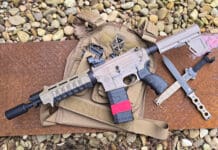 Joe Grine, Nick Leghorn and myself are amped up to cover the Joint Small Arms Conference of the National Defense Industry Association in May. I’m a complete noob when it comes to this kind of military-grade hardware, and I’m having trouble sleeping just thinking about shooting anything belt-fed, crew-served or rocket-propelled. Laser guns weren’t on the menu, or so I thought…
Joe Grine, Nick Leghorn and myself are amped up to cover the Joint Small Arms Conference of the National Defense Industry Association in May. I’m a complete noob when it comes to this kind of military-grade hardware, and I’m having trouble sleeping just thinking about shooting anything belt-fed, crew-served or rocket-propelled. Laser guns weren’t on the menu, or so I thought…
Then I noticed an intriguing item on the May 15th ‘Directed Energy Weapons’ panel agenda: “Miniature High-Power Microwave Systems Based on Explosive-Driven High-Voltage Ferroelectric Generators.” I know Obi-Wan hates them, but I’ve been all over laser blasters since the summer of 1977, so I dug a little deeper.
Directed-energy weapons are a class of weapons that includes lasers, particle-beam weapons and focused microwave emitters. Their massive power requirements have stymied efforts to miniaturize them for battlefield use, since traditional chemical batteries simply don’t have the megaampere-hours needed to light them up. The smallest mobile military laser that came anywhere near deployment filled the entire cargo area of a converted 747.
Batteries don’t work, so engineers are now looking hard at other power sources with the potential to get Han Solo’s laser blaster back in the fight. Strangely, many of them use old-fashioned chemical explosives as their primary energy source.
Shaped strangely like a shotgun shell, the explosive-driven ferroelectric generator uses a tiny charge of C4 to crush (and then basically vaporize) a small volume of magnetized iron-laden ceramic powder. As the expansion front from the C4 crushes the powder, the magnetized powder depolarizes and produces a powerful but brief jolt of electric current.
Right now, these single-shot generators are powerful enough to generate short-range EMP effects and directed microwave bursts to fry enemy electronic systems. With further development, though, they might provide enough portable energy to power a weaponized pulsed laser.
That’s right, a laser gun that goes bang and uses explosive-charged cartridges. Whether such weapons will ever rule the battlefield will depend on whether they can outperform traditional kinetic-energy penetrator weapons like firearms, and whether they can do it at realistic cost.
Those trials are a long way off, and in the meantime I’m pretty sure the present-day EMP and microwave bombs won’t be part of the Joint Base Lewis-McChord live fire demonstration (dude, what did you do to my iPod?). I plan on attending the discussion anyway; it’s only 20 minutes long, so even if I don’t understand the techno-speak I still won’t have to suffer too long in ignorance.
A real laser blaster might not be a more elegant weapon for a more civilized age, but Han can’t shoot first without one. Someday, at least.





“Hokey religions and ancient weapons are no match for a good blaster at your side, kid.”
Beat me to it!
See, it’s funny because he’s talking about Democrats and gun free zones…
Good one Nick, lmao.
HA!
Leave the weaponized pulsed laser, take the cannoli? That just sounds soooo wrong.
Trouble is, lasers cauterize wounds, and would probably not be an efficient man-stopper. In fact, people get shot in the heart with lasers quite frequently and live to tell about it:
http://www.texasheartinstitute.org/hic/topics/proced/tmlrs.cfm
Laser tag will never be the same again
Why’s that strange? Short of nuclear methods, chemical fuels contain some of the highest energy densities currently possible, while being very stable with a generally small footprint compared to anything else.
Compressed hydrogen will likely be the way “make lots of energy happen quick” science goes, ultimately. Right now chemical explosives are much cheaper and easier to work with.
phased plasma rifle in the 40 watt range
Hey, just what you see pal.
Who is going to start producing Chakan Oil to power these things?
DE weapons are still a century off from being practical. The future weapon technologies I’m looking forward to are:
1. Caseless ammo – C’mon scientists, it has been decades since the last attempt, there has to be a good way to do it.
2. Rail guns – Actually this technology is developing at a good pace (meaning mass production very possible within our lifetime). Only downside is the EMP like interference generated upon firing.
3. Electric ignition – While Metal Storm is interesting, stacking all the rounds in the barrel isn’t the best implementation IMO. A combination with more traditional style weapons would be interesting.
A century is a LONG time. Look what we do regularly that was not even theoretically possible to most people a century ago.
The way I see it, a country would have to be willing to make small nuclear reactors and put them in harm’s way in order to make portable lasers feasible. I highly doubt that any military would be willing to accept the possible loss or capture of nuclear components. The technology to make portable lasers is coming about rather rapidly, but portable power sources to operate them are not on the same track.
I sort of like what we’ve got, if suppressors are included. What I want them to invent is a humane but above all effective rehab process for violent criminals and other creeps that actually works. Giving them twenty years of free meals and medicine is reverse punishment. We need something that works in six months and they lose all interest in violence. Until then I’ll rely on the one-second solution.
That would be a lobotomy, which for rapist and child molestors, I’d be ok with. Might be a little overboard for the typical purse snatcher.
H&K came close with the G11. Of course some kinks needed to be worked out. Glue that held bullet to powder was prone to melting. It also had an awkward (read cranking) reload procedure. But peace killed the beauty. No more Cold War meant no money for high-tech small arms development.
Beat me to it, Charlie. G11 was a fascinating weapon. So ugly it’s beautiful and 4.7mm caseless ammunition. A very good read for any of you interested in the G11:
http://world.guns.ru/assault/de/hk-g11-e.html
I remember reading an article where the author was theorizing about a high powered LASER on a satellite in space, using a nuclear generator for power and GPS for targeting. He speculated that the technology already existed and described its use like this: Leader of the “evil empire” is known to be near such and such location, special forces are sent out to recon and verify his exact location. co-ordinates are called in and as the BAD GUY is talking to his henchmen, a burst of heat is felt and the guy disappears into a pile of ash in the center of a 1 meter dia burnt spot on the ground. The author named it the “Hammer of Thor”. Imagine henchmen “B”, “C” and “D” seeing their leader literally vaporized in front of them, would definitely give them something to think about, especially if they are semi-literate and superstitious.
Hence the script of “Real Genius”.
Unfortunately powering a laser large enough to cook a human from orbit some 200 miles away is not trivial, even with a nuke plant. You wouldn’t need a satellite, you’d need a space station. A big one. Built in orbit.
Then, assuming you wanted to be able to zap anything anywhere, it would need to be in a polar orbit, which means you’d have a limited window to zap a particular place at a particular time.
All in all, much more complex and massively more expensive than dropping a bunch of JDAMs on the bad guys or go UAV hunting.
Well, I would think it’s not going to be the kind of thing that gets fired very often, maybe a smallish power plant charging capacitors for that once every 3 month shot that lasts 5 seconds? And I sure agree that JDAMS are going to be MUCH cheaper, but then there is the risk of collateral damage. Seemed kind of “tidy” to me to be able to ash-erize one single individual. And that moment 3 seconds after the bad guy basically becomes smoke, absolutely HAS to be a GREAT Kodak moment.
JDAMS aren’t exactly cheap. The most recent version, the MOP (dsigned to penetrate 30 stories of reinforced concrete–i.e. Iran’s underground uranium enrichment facilities) cast a cool $4M per. A rail gun from space would be cheaper and more effective if you culd design a penetrator that would survive re-entry. Here’s a link to one in action. http://defensetech.org/2011/04/14/we-were-launching-hypersonic-bricks-at-mach-5-mach-6/
“…if you culd design a penetrator that would survive re-entry.”
How ’bout these?
http://www.popsci.com/scitech/article/2004-06/rods-god
http://www.cracked.com/article_16477_5-famous-sci-fi-weapons-that-theyre-actually-building.html
Was the author Jerry Pournelle? Yeah, that fantasy has existed for decades. The problem is that bad governments can use Dr. Evil’s Death Ray just as well as better governments, can’t they?
Chris, I can’t remember who wrote it, it was an article in some gun magazine that I read more than 5 years ago. I’ve slept since then, and details like author’s names slide out of my brain after than much time. I think the only reason I remember it at all was the “Hammer of Thor” name as I liked reading Thor comics back when I was a kid.
All I know is, somebody will be “cleaning” one, and it will “go off”.
Joe Grine, Nick Leghorn and I…
Everyone else made the starwars references, so I’ll go ahead and plot out that lasers are a terrible anti personell weapon, not only must they be focused tightly, which reduces the amount of target tissue damaged to a small area, maybe a pincil width to maybe an inch at most, and not only do they cauterize the wound, making it more survivable, but MOST IMPORTANTLY, they can be defeated completely with a simple mirror or reflective armor.
Sorry sports fans. But laser are damn nigh useless as a weapon once people know you are using it.
Comments are closed.